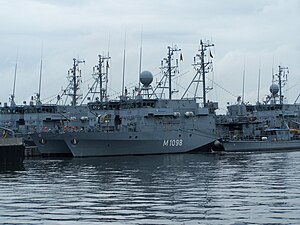
A remotely operated vehicle (ROV) is a free-swimming submersible craft used to perform tasks such as valve operations, hydraulic functions and other general tasks within the subsea oil and gas industry. ROVs can also carry tooling packages for undertaking specific tasks such as pull-in and connection of flexible flowlines and umbilicals, and component replacement.

HMAS Geranium was an Arabis-class sloop built in Scotland and launched in 1915. The ship was operated by the Royal Navy as a minesweeper from 1915 until 1919, when she was transferred to the Royal Australian Navy (RAN) for use as a survey ship between 1919 and 1927. The ship was decommissioned in 1927 and scrapped during 1932, with the remains scuttled in 1935.
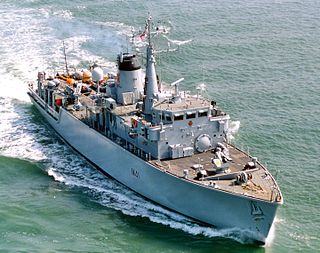
The Hunt class is a class of thirteen mine countermeasure vessels of the Royal Navy. As built, they combined the separate roles of the traditional minesweeper and that of the active minehunter in one hull, but later modifications saw the removal of mine-sweeping equipment. They have a secondary role as offshore patrol vessels.

The Sandown class is a class of fifteen minehunters built primarily for the Royal Navy by Vosper Thornycroft. The Sandown class also serve with the Royal Saudi Navy, the Estonian Navy, and the Ukrainian Navy. The first vessel was commissioned into Royal Navy service on 9 June 1989 and all the British ships are named after coastal towns and cities. They have a secondary role as offshore patrol vessels.

The Aggressive-class minesweepers are a class of US-built minesweepers. They are designated as MSO, distinguishing them from the smaller coastal MSCs and inshore MSIs. Besides the US Navy, this class of vessels has also been used by the Belgian Navy and the Norwegian Navy, among others.

The Ton class were coastal minesweepers built in the 1950s for the Royal Navy, but also used by other navies such as the South African Navy and the Royal Australian Navy. They were intended to meet the threat of seabed mines laid in shallow coastal waters, rivers, ports and harbours, a task for which the existing ocean-going minesweepers of the Algerine-class were not suited.
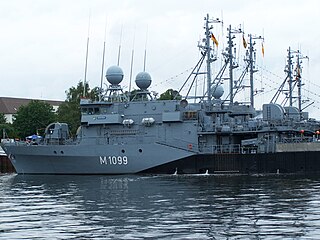
The Type 333 Kulmbach class is a class of five German Navy ships. Built as Type 343 Hameln class minesweepers, they have been upgraded to minehunters using Seefuchs expendable drones to detonate detected naval mines.
Mine Squadron 7, is the designation for a United States Navy minelaying and retrieval command and unit. COMINRON SEVEN was assigned to the United States Pacific Fleet from some time before 1943 until the unit's decommissioning in 1968. The word Commander in the unit's nomenclature refers both the entire unit, the headquarters section, and to the actual commanding officer.

Type 320 Lindau-class minehunters was a class of German coastal minehunters built as part of the first FRG naval program. The ships were made from non-metallic components and built by Burmester Bremen. None of these ships now remain in service with the German Navy. Several went into service with the Estonian and Lithuanian Navy, as well as the Latvian Naval Forces. Flensburg and Weilheim became museum pieces.
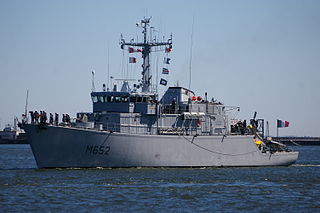
The Tripartite class is a class of minehunters developed from an agreement between the navies of Belgium, France and the Netherlands. A total of 35 ships were constructed for the three navies. The class was constructed in the 1980s–1990s in all three countries, using a mix of minehunting, electrical and propulsion systems from the three member nations. In France, where they are known as the Éridan class they are primarily used as minehunters, but have been used for minesweeping and ammunition transport in Belgium and the Netherlands, where the Tripartites are known as the Alkmaar class.

The Kuha-class minesweepers is a series of six inshore minesweepers of the Finnish Navy. The ships were constructed in 1974–1975. All the vessels of the class were modified and modernized in the late 1990s, including a lengthening of the hull. Two of the class were withdrawn from service in 2012. The rest of the class will be retired with the entry into service of the Katanpää-class mine countermeasure vessels.

The Royal Naval Patrol Service (RNPS) was a branch of the Royal Navy active during both the First and Second World Wars. The RNPS operated many small auxiliary vessels such as naval trawlers for anti-submarine and minesweeping operations to protect coastal Britain and convoys.
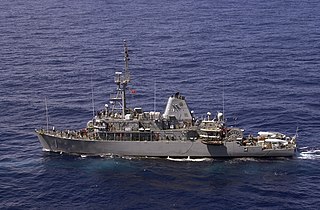
Avenger-class mine countermeasures ships are a class of 14 ships constructed for the United States Navy from 1987 to 1994, designed to clear mines from vital waterways. The ships have the hull designator MCM.

The M class were the standard minesweeper of Nazi Germany's Kriegsmarine during World War II. The vessels were the primary force in Germany's harbor defense command and were organized administratively into minesweeper flotillas.

The Fleet-class unmanned surface vessel, also called the Common Unmanned Surface Vessel (CUSV) and later the Mine Countermeasures Unmanned Surface Vehicle, is an unmanned surface vessel designed for the United States Navy to be deployed from Freedom and Independence-class littoral combat ships and intended to conduct mine and anti-submarine warfare missions. As of 2012 four units of the class have been built; the first was delivered to the U.S. Navy in 2008.

The Craft of Opportunity Program (COOP) was a Royal Australian Navy (RAN) acquisition program intended to supplement the navy's mine warfare capability with civilian vessels that could be quickly converted into minesweepers. Vessels acquired under COOP were not commissioned into the RAN, and instead operated with the prefix "MSA" (Minesweeper Auxiliary).

The Mine Warfare Force belonged to the minesweeping force for the self-defense fleet of the Maritime Self-Defense Forces. Its main task is to lay naval mines in the event of an emergency, and it also helps to dispose of mines installed during World War II.
